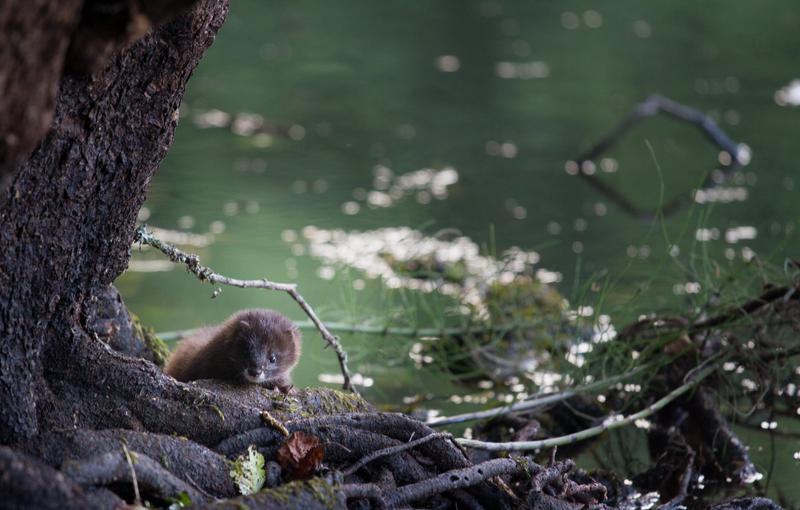

European Mink
Tiit Maran
The European mink (Mustela lutreola) is one of the most endangered mammals in Europe. The reasons for its decline are the destruction of its habitat in riparian areas, competition with the alien American mink and historically, extensive hunting.
The European mink is often confused with the American mink (Neovison vison, previously Mustela vison), which has successfully established itself in Europe as an escapee from fur farms. The larger and more robust American mink has nearly completely replaced the European mink in its previous range.
Species protection projects all over Europe have so far faced the problem that European minks are difficult to breed in zoos. Captivity appears to have a negative effect on breeding success. But captive-bred individuals are needed in order to release and reintroduce the animal into protective zones. “The more we know about the physiology of European minks, the better we can respond to their needs,” says lead author Franz Schwarzenberger from the Institute of Physiology, Pathophysiology and Experimental Endocrinology at the University of Veterinary Medicine, Vienna.
Faecal samples yield reproductive data
Scientists from the Vetmeduni Vienna, in cooperation with the Endangered Species Research Lab of Tallinn Zoo, collected faecal samples from European mink and analysed them in Vienna. The animals are managed under the aegis of an EEP program (European Endangered Species Program). Female oestrus is usually determined by vaginal cytology. The aim of the study was to assess the validity of this method and to optimise diagnosis of ovulation and pregnancy.
“Using our non-invasive method, we were able to measure female oestrogen levels and generate a seasonal hormone profile. The results showed that oestrogen levels are higher at the time of ovulation. Such oestrogen peaks occur three to four times a year on average. The animals are polyoestrous. That means, during the breeding season they are fertile in regular intervals. In the past, females which had already been mated with no success were not mated again that same year. Our results reveal that mating can occur much more often,” Schwarzenberger explains.
Looking for the perfect mate
European minks are solitary animals and extremely territorial in the wild, only approaching each other during the breeding season. In captivity, the animals are housed in large individual enclosures. “The exact time for mating is difficult to determine in a zoo because the animals attack each other if they aren’t receptive. In order to increase the chances of fertilisation, the females are examined at regular intervals during the mating season. During mating, we also closely observe the behaviour of the animals, especially of the males,” explains Astrid Nagl, first author of the study.
The Tallinn Zoo uses vaginal cytology to predict the time of ovulation. This method does not always yield satisfactory results, however. “The data from the faecal analysis serve to augment the available information so that some females which had previously not been mated successfully also had offspring,” Schwarzenberger reports.
Reintroduction in Europe not possible everywhere
The reintroduction of the European mink in Austria would not be easy. “In Austria, the American mink has replaced the European mink in aquatic and riparian zones,” says Schwarzenberger. Releasing the European mink in this habitat would be tantamount to a death sentence, as the American minks would defend their territory and kill the European Mink. This makes reintroduction only possible in areas where no populations of American mink exist,” says Schwarzenberger.
About 100–120 European mink live at Tallinn Zoo. The zoo’s captive-bred animals are reintroduced to the wild on the Estonian islands of Hiiumaa and Saaremaa. Another promising reintroduction project can be found at Steinhuder Meer in northwest Germany.
Service
The article “Non‐invasive monitoring of female reproductive hormone metabolites in the endangered European mink (Mustela lutreola)”, by Astrid Nagl, Nadja Kneidinger, Kairi Kiik, Heli Lindeberg, Tiit Maran and Franz Schwarzenberger was published in the journal Theriogenology. http://www.sciencedirect.com/science/article/pii/S0093691X15003817
About the University of Veterinary Medicine, Vienna
The University of Veterinary Medicine, Vienna in Austria is one of the leading academic and research institutions in the field of Veterinary Sciences in Europe. About 1,300 employees and 2,300 students work on the campus in the north of Vienna which also houses five university clinics and various research sites. Outside of Vienna the university operates Teaching and Research Farms. http://www.vetmeduni.ac.at
Scientific Contact:
Prof. Franz Schwarzenberger
Institute of Physiology, Pathophysiology and Experimental Endocrinology University of Veterinary Medicine Vienna (Vetmeduni Vienna)
T +43 1 25077-4104
franz.schwarzenberger@vetmeduni.ac.at
Scientific Contact (Tallinn Zoo):
Tiit Maran, Ph.D.
Species Conservation Lab, Tallinn Zoo
phone +372 6943318
GSM +372 5066859
tiit.maran@tallinnzoo.ee
Released by:
Heike Hochhauser
Corporate Communications
University of Veterinary Medicine Vienna (Vetmeduni Vienna)
T +43 1 25077-1151
heike.hochhauser@vetmeduni.ac.at
http://www.vetmeduni.ac.at/en/infoservice/presseinformation/press-releases-2015/…












